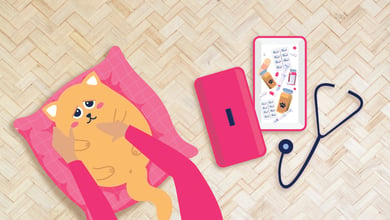Creating a Safe Place for Dogs: 7 Vet-Approved Tips
Sometimes we all need a break, and so does your pup! Your dog might be naturally shy or nervous around different kinds of people, be fearful of loud noises or events, or deal with separation anxiety when left alone.
Even if you’ve got a chilled-out pooch, creating a safe place for your furry friend can help expedite house and obedience training and provides a comfortable place for him or her to go when they want to relax!
Giving your dog the choice and autonomy to leave a situation increases their confidence in dealing with uncertain or stressful situations.
How to Create a Safe Place for Dogs
A safe place for a puppy should include a “potty zone,” while a housebroken adult dog doesn’t require one. If your pup is already crate trained, think of the safe space as an extension of their crate.
The safe place should be viewed positively, and your pup should ideally enjoy being in his or her special place. For this reason, many owners will put their dog’s crate inside their safe place.
Are You a Pet Safety Expert?
1. Which one of the plants below is toxic to cats if ingested?
2. Which of the foods below is generally considered safe for your dog to eat?
3. Above what temperature is too hot to leave a pet in your car?
4. Which kind of leash is the safest to walk your dog?
5. True or False: If a medication is safe for humans, it is probably safe for pets.
6. What should you do if you think your pet ate something toxic?
View Results
Are You a Pet Safety Expert?
1. Which one of the plants below is toxic to cats if ingested?
2. Which of the foods below is generally considered safe for your dog to eat?
3. Above what temperature is too hot to leave a pet in your car?
4. Which kind of leash is the safest to walk your dog?
5. True or False: If a medication is safe for humans, it is probably safe for pets.
6. What should you do if you think your pet ate something toxic?
Share Quiz
When creating your dog’s safe place, a few elements can help make it feel as cozy and appealing to your pup as possible.
1. Ensure comfort for your dog
Making sure your dog is physically comfortable in his or her safe place is essential to the success of the safe place. This includes temperature, comfort items or toys, and enough room to go full sploot!
2. Incorporate food and water
Feeding your dog in his or her safe space can help create positive associations with the area. If your dog loves their food, it is a great idea to feed your pup in a safe place.
Additionally, your dog’s safe place should have accessible water, ideally in a spill-proof bowl, so your pooch can drink without wetting the floor or bedding. If your dog is having trouble eating, please schedule a nutritional consultation with a veterinarian.
3. Provide easy access
It is important that the safe place is easy for your dog to access. Your dog’s safe place should be nearby the main rooms of the house or wherever your dog typically likes to hang out. The safe place should never be used for time-outs or punishment as that will likely encourage your pup to view his or her safe place as negative.
4. Promote a stress-free environment
You can make your dog’s safe space as comfortable as possible by tailoring it to your pet’s individual needs and sensitivities. If your pooch fears loud noises, adding a white noise machine or a fan can help alleviate stress while inside a safe place.
Additionally, there are certain types of music that have been shown to reduce anxiety in dogs. The Washington Post found that Reggae, Soft Rock, and Classical are the most relaxing genres of music you can play for your pup! Bob Marley, anyone?
There are also CDs and playlists designed specifically for canine friends. If you go to a music-sharing platform, such as Spotify or Pandora, you will be able to find plenty of soundtracks with just a quick search.
5. Make the space stimulating and enriching
Providing some toys and long-lasting chews for your dog while he or she is in their safe space can help make the area feel more enticing and rewarding. This is particularly important if you plan to leave your dog in his or her safe place while you are out of the house. Puzzle toys and Snuffle Mats are great examples of boredom-busting activities you can give to your pup.
6. Dog-proof the area for safety
Likely the most important aspect of your dog’s safe place is safety. The safe place must be dog-proofed, with no dangerous items or hazards.
Here is a quick list of dangerous items to look out for:
- Trash and other ingestible items
- Cords, wires, and outlets
- Open bags and potential suffocation hazards
- Medications and drugs
- Poisonous houseplants
- Heights
- Batteries
- Toys that are easily destroyed and eaten
7. Train for retreat and reward
Encouraging your dog to retreat to his or her safe place when your home feels chaotic, or you notice that your pup might be overwhelmed will help to establish a safe place as a refuge. Anytime you see your pup go into his or her safe place, give him or her a treat or reward to further reinforce the behavior.
Conclusion
Creating a safe place for your dog is essential to their overall well-being and training. It provides them with a comfortable and secure space where they can relax and feel at ease. By incorporating the elements of comfort, food and water, easy access, stress reduction, stimulation, and safety, you can ensure that your dog's safe place is a positive and inviting environment for them.
If you need guidance or assistance with creating a safe place for your dog, consider reaching out to BetterVet. Our team of veterinarians understands the importance of providing a nurturing environment for your pet. We offer veterinary check-ups and a range of other services to ensure your pet's happiness and well-being.





